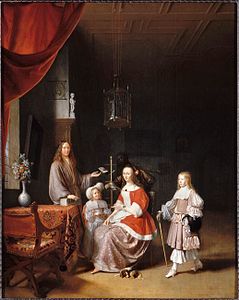Petticoat breeches
Full, knee-length trousers worn by men in the 17th–18th centuries
Petticoat breeches were voluminously wide, pleated pants, reminiscent of a skirt, worn by men in Western Europe during the 1650s and early 1660s.[1] The very full loose breeches were usually decorated with loops of ribbons on the waist and around the knee. They were so loose and wide that they became known as petticoat breeches. They give very much the impression of very baggy loose shorts since they are not gathered at the knee.
They replaced Spanish breeches during the 1650s as the most popular leg wear of most of Western Europe. By the early 1660s, if they were gathered at the bottom they were called rhinegraves.
-
 Gerard Jansz Meerman wearing petticoat breeches, 1668
Gerard Jansz Meerman wearing petticoat breeches, 1668 -
![Portrait of a Boy, by Jan van Noordt, 1665[2]](//upload.wikimedia.org/wikipedia/commons/thumb/5/59/Jan_van_Noordt_-_Portrait_of_a_Boy_-_1665.jpg/232px-Jan_van_Noordt_-_Portrait_of_a_Boy_-_1665.jpg) Portrait of a Boy, by Jan van Noordt, 1665[2]
Portrait of a Boy, by Jan van Noordt, 1665[2] -
![Portrait of Count Girolamo Secco Suardo, by Fra' Galgario, 1721[2]](//upload.wikimedia.org/wikipedia/commons/thumb/f/f5/Vittore_Ghislandi_-_Portrait_of_Count_Girolamo_Secco_Suardo_1721.jpg/164px-Vittore_Ghislandi_-_Portrait_of_Count_Girolamo_Secco_Suardo_1721.jpg) Portrait of Count Girolamo Secco Suardo, by Fra' Galgario, 1721[2]
Portrait of Count Girolamo Secco Suardo, by Fra' Galgario, 1721[2]
References
- ^ Planche, J.R. (2013). An Illustrated Dictionary of Historic Costume. Dover Fashion and Costumes. Dover Publications. p. 57. ISBN 978-0-486-14533-4. Retrieved 27 July 2018.
- ^ a b 20,000 Years of Fashion, page 259
External links
- Pieter de Hooch Paintings Two pages of paintings of Dutch men in petticoat breeches by Pieter de Hooch.

Wikimedia Commons has media related to Petticoat breeches.

![Portrait of a Boy, by Jan van Noordt, 1665[2]](http://upload.wikimedia.org/wikipedia/commons/thumb/5/59/Jan_van_Noordt_-_Portrait_of_a_Boy_-_1665.jpg/232px-Jan_van_Noordt_-_Portrait_of_a_Boy_-_1665.jpg)
![Portrait of Count Girolamo Secco Suardo, by Fra' Galgario, 1721[2]](http://upload.wikimedia.org/wikipedia/commons/thumb/f/f5/Vittore_Ghislandi_-_Portrait_of_Count_Girolamo_Secco_Suardo_1721.jpg/164px-Vittore_Ghislandi_-_Portrait_of_Count_Girolamo_Secco_Suardo_1721.jpg)











